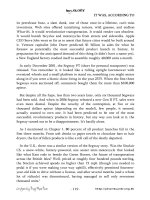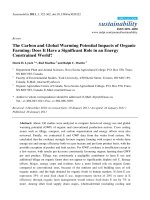First, it was a rancho
Bạn đang xem bản rút gọn của tài liệu. Xem và tải ngay bản đầy đủ của tài liệu tại đây (2.08 MB, 6 trang )
Reader
Genre
Build Background
Access Content
Expository
Nonfiction
• Hispanic Culture
• Mexico and the
United States
• Influence of
Spanish on
English
• Labels and
Captions
• Map
• Definitions
• Historical
Photographs
Extend Language
• Words of the
West and
Southwest
• Names of
Groups of
Animals
Scott Foresman Reading Street 4.2.2
ì<(sk$m)=bebjdh< +^-Ä-U-Ä-U
ISBN 0-328-14193-3
by Luz Paredes
Talk About It
1. Why were there wild cows and horses on the
frontier?
2. Why would people want to settle on the open
lands that had wild cows and horses but not many
other people?
Write About It
3. On a separate paper, make a list of the clothing
the vaqueros and cowboys wore. Write about the
clothing you think was most useful to them. What
protected them from bright sunlight, strong wind,
or the dangers of their work?
Extend Language
Groups of animals have special names in English. For
example, a group of cattle, sheep, or goats is a herd.
Here are other names of animal groups:
school of fish
swarm of locusts
pack of wolves
pride of lions
Look up the word flock in a dictionary to find out
the groups of animals that it names.
Photographs
Cover ©David Stoecklein/Corbis; 1 ©Bill Manns/The Art Archive; 3 ©Digital Wisdom,
Inc.; 4 ©Bill Manns/The Art Archive; 5 ©Steve Kaufman/Corbis; 7 ©NGS Image
Collection; 8 ©David Stoecklein/Corbis.
ISBN: 0-328-14193-3
by Luz Paredes
Copyright © Pearson Education, Inc.
All Rights Reserved. Printed in the United States of America.
This publication is protected by Copyright, and permission should be obtained from
the publisher prior to any prohibited reproduction, storage in a retrieval system,
or transmission in any form by any means, electronic, mechanical, photocopying,
recording, or likewise. For information regarding permission(s), write to: Permissions
Department, Scott Foresman, 1900 East Lake Avenue, Glenview, Illinois 60025.
Editorial Offices: Glenview, Illinois • Parsippany, New Jersey • New York, New York
Sales
Massachusetts
• Duluth,
Georgia • Glenview, Illinois
1234
5 6 7Offices:
8 9 10 Needham,
V0G1 14 13
12 11 10 09 08
07 06 05
Coppell, Texas • Sacramento, California • Mesa, Arizona
Spanish Names
Have you ever noticed that many places in the
West and Southwest of the United States have
Spanish names? For example, there are the states
of Colorado and Nevada. The word colorado
means “red” in Spanish, and nevada means
“snow-capped,” as in “snow-capped mountain.”
Look at a map that shows places in Colorado,
Nevada, California, New Mexico, Utah, Wyoming,
Arizona, and Texas. You will see many more
places with Spanish names—towns, cities, rivers,
lakes, deserts, valleys, and mountains. For
example, the city of Los Angeles has a name that
means “the angels.” The name Rio Grande, for
the big river in New Mexico and Texas, means
“big river.” There’s a good reason so many places
in the West and Southwest of the United States
have Spanish names. About 150 years ago, all
that land was part of Mexico, where Spanish is
spoken.
Shaded in yellow: In 1836, United States settlers formed
the Republic of Texas and broke away from Mexico.
Later it became the state of Texas.
Shaded in red: After a war between the United States
and Mexico, in 1848 Mexico turned this land over to
the United States.
Shaded in green: In 1853, Mexico sold this land to the
United States.
Wyoming
Nevada
Las Vegas
Utah
Pueblo
Colorado
Santa Fe
California
Arizona
New
Mexico
Los Angeles
Texas
Mexico
San Antonio
2
3
Everything
that a
vaquero
wore and
carried was
useful to
him in his
work.
Before 1821, Mexico was a colony of Spain
called New Spain. In 1821, Mexico became
independent.
When Mexico was a Spanish colony, the
kings of Spain gave large pieces of the land to
their loyal followers. These large pieces of land
became ranchos, or ranches. The ranches had
large herds of cattle that had been running wild
in the region. The ranch owners hired horsemen
to work with the wild herds. These horsemen
were called vaqueros, or cowboys. The word
vaquero comes from the Spanish word vaca,
which means cow.
4
After Mexico won its independence from
Spain, the government continued giving land to
people willing to settle in some places. People
worked quickly to turn their land into ranchos.
These Mexican lands had many wild horses and
cows, especially around the area that is now
southern Texas. These animals came from horses
and cows that early Spanish expeditions had
brought to North America.
expeditions: groups of people making journeys to
explore lands
5
hat
By the 1830s, there were perhaps millions of
wild horses and cows running free on the land.
People who caught those animals could keep
them. Everything on the frontier—the open land,
the animals—was ideal for the ranching way of
life to develop. This way of life began when the
land was part of New Spain. It continued when
the land became part of Mexico, and it went on
when the land became part of the United States.
bridle
rope
saddle
reins
boot
chaps
stirrup
Extend Language
Words of the West
and Southwest
As settlers came to places that are now the West and
Southwest of the United States, they began to use
Spanish words such as adobe, bronco, corral, patio,
rodeo, and hacienda. These words are spelled exactly
the same way in Spanish and English.
But the settlers changed other Spanish words,
spelling them quite differently in English. Look at
these words.
vaquero buckaroo lazo lasso
la reata lariat
Vaquero means “cowboy.” The word buckaroo is
another word in English for cowboy. Look up lasso
and lariat in a dictionary to learn what they mean.
6
The Spaniards also brought their ways of
working with the animals. In Spain, men rode
on horseback to herd cattle. They put brands,
or marks, on animals to identify them. They also
held roundups, called rodeos in Spanish. The
vaqueros taught American cowboys these skills
after the land became part of the United States.
U.S. cowboys also wore spurs and much of the
same practical clothing that vaqueros wore.
7
Talk About It
1. Why were there wild cows and horses on the
frontier?
2. Why would people want to settle on the open
lands that had wild cows and horses but not many
other people?
Write About It
3. On a separate paper, make a list of the clothing
the vaqueros and cowboys wore. Write about the
clothing you think was most useful to them. What
protected them from bright sunlight, strong wind,
or the dangers of their work?
Extend Language
Groups of animals have special names in English. For
example, a group of cattle, sheep, or goats is a herd.
Here are other names of animal groups:
school of fish
swarm of locusts
pack of wolves
pride of lions
Vaqueros pose for a picture in Texas.
There are still vaqueros in the West and
Southwest, working side by side with cowboys.
They continue to do the work the first vaqueros
did—herding and roping cattle. But the land is
not so open anymore, and the cows and most
of the horses are no longer wild. Still, the old
cowboy feelings remain—the love of the land
and its animals, and the pride in hard work.
Look up the word flock in a dictionary to find out
the groups of animals that it names.
Photographs
Cover ©David Stoecklein/Corbis; 1 ©Bill Manns/The Art Archive; 3 ©Digital Wisdom,
Inc.; 4 ©Bill Manns/The Art Archive; 5 ©Steve Kaufman/Corbis; 7 ©NGS Image
Collection; 8 ©David Stoecklein/Corbis.
ISBN: 0-328-14193-3
Copyright © Pearson Education, Inc.
All Rights Reserved. Printed in the United States of America.
This publication is protected by Copyright, and permission should be obtained from
the publisher prior to any prohibited reproduction, storage in a retrieval system,
or transmission in any form by any means, electronic, mechanical, photocopying,
recording, or likewise. For information regarding permission(s), write to: Permissions
Department, Scott Foresman, 1900 East Lake Avenue, Glenview, Illinois 60025.
1 2 3 4 5 6 7 8 9 10 V0G1 14 13 12 11 10 09 08 07 06 05
8









